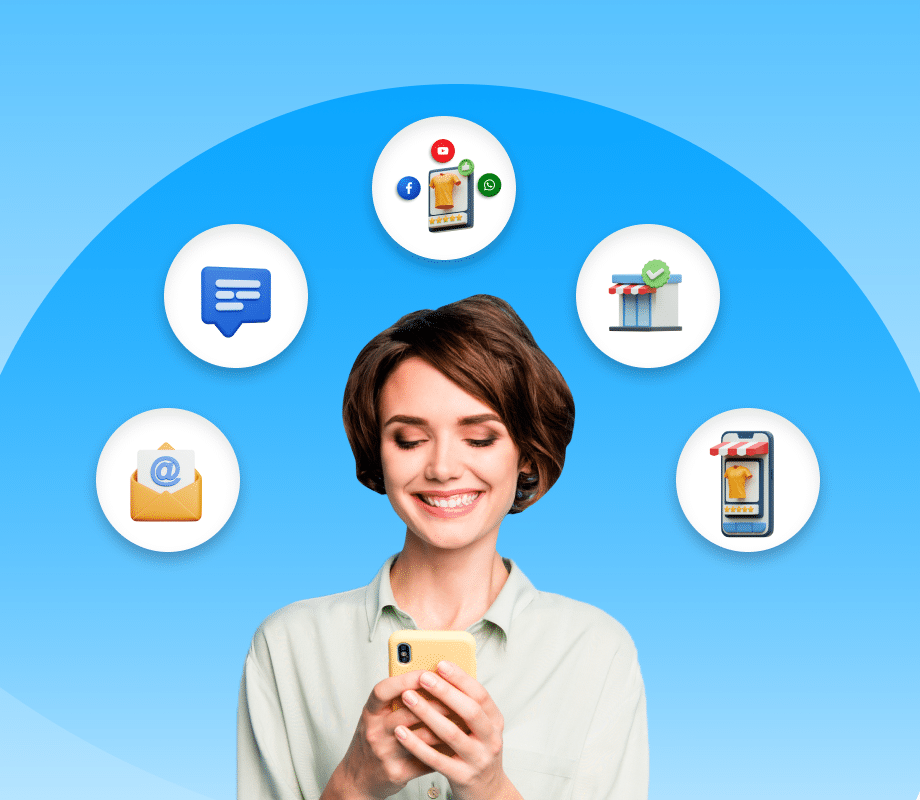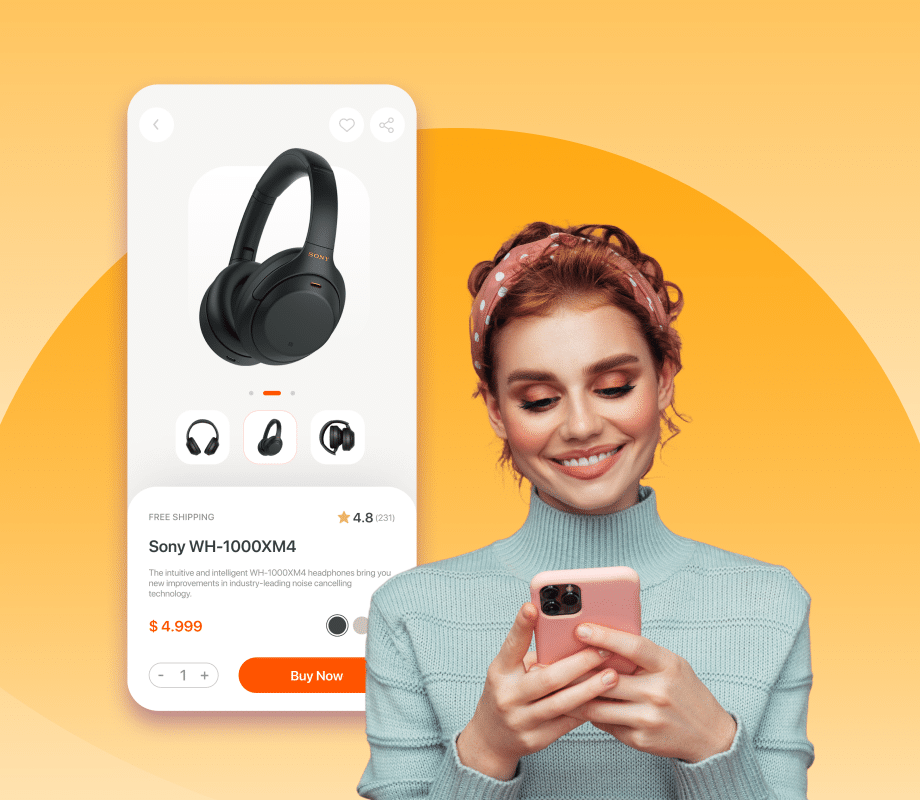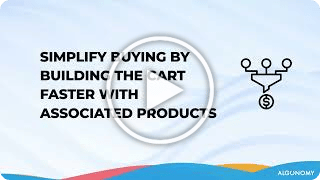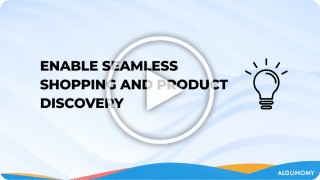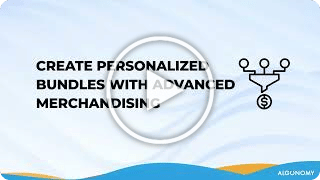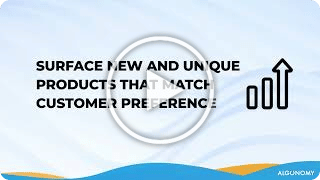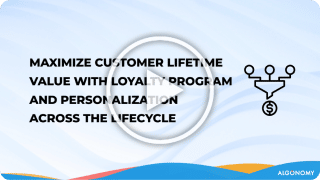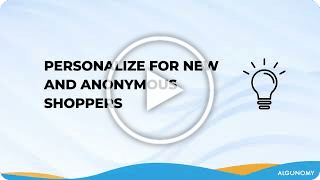Personalization Lessons From B2B eCommerce Pioneers
Share it on
Oliver Carmona:
Thank you for joining us. For this session. This session is personalization lessons from b2b e commerce pioneers. You know, b2b buyers have embraced the rapid shift to e commerce and online channels. But the intricacies of account structures, custom catalogues and variable pricing, add unique challenges for businesses seeking to make the online browsing and buying experience as seamless as possible.
In this session, we showcase two leading companies leveraging b2b personalization to drive shopping efficiency, boost up and cross sell, and increase lifetime value and loyalty. My name is Oliver Carmona, Senior Director of Customer Success with RichRelevance(now Algonomy) leading personalization technology provider with expertise in both b2b and b2c retail. And it’s a pleasure to introduce our panellists for this session.
Jeff Serota, Senior Director of Product Management for Staples Canada, he’s responsible for customer facing technology for their open ecommerce sites staples.ca and they’re closed b2b e commerce sites satplespreferred.ca. Prior to joining Staples, Jeff has held product management roles at staples.com, Staples business advantage, Walmart, Canada and Dell. Staples, as you know, has hundreds of locations across Canada and is dedicated to helping customers which include entrepreneurs, educators, students and parents work learn and grow. And Jeff is joining us from Toronto.
Also joining us is Ben Pinder. Ben is a digital specialist and I like to call personalization expert at Insight Direct in the UK. Ben drives in overseas insights personalization efforts. His role in digital marketing looks after website optimization and personalization for me. Now, having been successful with a triple scholarship to study to Master’s degrees and entrepreneurship and a Nanodegree. In front end development, then is an expert in forming and maintaining b2b relationships through digital personalization concepts and theories. Insights prides itself on its hunger to help them serve their clients with tech solutions, be it hardware, software, or services, and then joins us from Sheffield, UK.
So as more and more business buyers are moving online, you know, a tremendous amount of buyers now 67%, in fact, of business buyers are now purchasing over a quarter of their corporate goods and services online. And as they do, their expectations are increasing. In fact, they’re taking the shopping experiences, from there, you know, from digitally from digital leaders in their personal life like Amazon and Netflix and Uber. And they want to apply the same simplicity and seamlessness, and relevancy in their work related shopping and purchasing. As a b2b provider, you guys are expected to understand your customers like never before, and to demonstrate that you appreciate them as a professional as well as an individual in their specific role while also respecting, and acknowledging the restrictions at the account level things like different buying limits, contracts and special Pricing Agreements, customized product catalogues and service offerings. And, you know, given those very high expectations, and all the complexity of serving, serving the b2b customer, I’ll tee this up for you, Jeff, what are you doing at Staples to optimize the business experience and provide the most relevant, you know, shopping process for your customers?
Jeff Serota:
Thanks, Oliver. I think optimizing the buyer experience is supremely important for us making sure that people can get in and get what they need, and the supplies they need to keep their businesses going. So we rely on personalizing the experience as much as possible. Making sure the tools are right at their fingertips. If their orders waiting for approval. It’s easy to get there are things that are time to reorder. We know if you’re going to order every month, the things that you need to reorder, we put front and centre and promotions that are highly relevant. Really need to be front and centre for everybody.
Oliver Carmona:
Yeah, that’s great. Ben, share your thoughts, please.
Ben Pinder:
Yeah, sure. All of us. So inside, we’re really tailoring our digital environment to meet each customer’s needs. We want to make sure that what whatever they want and whenever they want, it’s available at the forefront of our digital ecosystem. And it’s relevant to them when they get there. So for example, we recognize that each customer is different. So we want to make sure that you know the experience they receive is suitable to each customer’s needs by doing that, An example is where we’re giving a unique experience, for instance, to new users who might come to the website and learn more about what insights are about and capable of doing. Whereas a returning customer might learn more about or receive content specifically focused on the business problems that they’re having. And the solutions we have capable of tailored to those problems.
Oliver Carmona:
That’s great. Ben then how do you ensure that what you’re doing is relevant across the entire ecommerce journey, you know, whether, you know you have customers, whether they’re first time customers are repeat customers, when they come to a homepage, or when they’re looking at a product page, and they’re trying to decide whether or not the products right for them? Or what product they should buy with that? Or whether it be your kind of homepage carousels and promotions and offers or email, how do you be sure that, that on these all these different customer touchpoints that you’re doing everything you can to leverage what you know about the customer?
Ben Pinder:
Yeah, great question. So what we do there is we spend a lot of time truly understanding what the shopper psychology is at certain stages in the buying funnel. So for example, you mentioned the homepage, on the homepage, the psychology of the shopper is more focused around the discovery and navigational aspects. That is that to mean that the shopper is very much thinking about, you know how to find the products that they’re looking for and discovering exactly what it is that they want. And we focus our strategies around our recommendations about that. So the products that are recommended will be very much mind designed to help the customer find what it is they’re looking for. Once the customer is found that and for instance, they’ve moved over to the product detail page. At that point, we switch over to Mr. upsell, cross sells type strategy, to enable us to make sure that we’re able to serve similar type products to the products the customer looking they’re looking at. And also, we can at that point, make the most of, as I’ve said over selling on top of these products.
Oliver Carmona:
Makes perfect sense. Jeff, I’d love your your thoughts on that particular topic as well.
Jeff Serota:
Absolutely. I mean, I agree with Ben, I think as customers travel down that purchase funnel, you know more about what they’re doing with that specific journey. So you can do more targeting. So we’re able to on a product page or even in a cart, really look at what their intent is. And work on growing that basket and giving them what they need and what they’re looking for. And then on the other side, up on the funnel, we’ve got our homepage, our emails where we really want to make sure we’re dealing with personalized content. So that I mean, we deal with lots of people in lots of different areas of business. So I don’t want to send a clean, excuse me, a cleaning supplies focused email or banner in front of somebody we know is looking to buy technology. So I need to use that real estate in a smart way in a personalized way that understands each individual user and what I know about them to get the right content in front of them. So as they move down that funnel, we can also offer the right products. So it’s really understanding where they’re at in that journey, and how much information we can use to leverage to make a more personalized experience.
Oliver Carmona:
Yeah, that’s make total sense, as you employ these methods and tactics to ensure that the customer experience is as relevant as possible. How do you measure that? What are the things that you’re doing? To kind of gauge the success of the shift that you’re trying to make with the customer experience? What are what are some of the specific efforts of what you’re maybe most proud of? And I’ll start with Jeff on that.
Jeff Serota:
So I mean, we value success based on engagement. It’s really about what are what are customers interacting with? And are we getting them the right thing in front of them at the right time. I’m really proud about my team, and who we’ve got him and all the great things we’ve delivered for our customers, and especially around what we’ve done specifically on personalization, about getting blog content and small business content and resources that people need to keep their small business going, especially in a troubling time like this, as well as the products that people need. We’re able to move very, very quickly and get the right things in front of the right people. Small businesses, especially again, in this environment, are looking to figure out how to move quickly and how to spend time where time is valuable. And looking and trying to hunt for the right thing on my website is not the right thing for them. So getting the right products in front of them the right information in front of them is supremely important for us and I think that we’re doing a great job of it. I’m very proud of what staples is able to do for small businesses in Canada.
Oliver Carmona:
You know, just the kind of the Staples mission is to help your customers work, learn and grow There are a concerted effort to spend more time developing learn content, to complement the transactional experience of just finding products and in transacting, how do you approach developing that content and ensure that you’re investing in the right areas?
Jeff Serota:
Yeah, we’ve got a great marketing team that helps put together that content, we really used to be about being the office supply Superstore, where people just came in and got the things they need and left. But we’ve got a lot of knowledge and a lot of expertise that we can help people do a better job working and learning. And so building up that content and making sure we’re funnelling people through how to pick the right products, and how to pick the right solutions for whatever the problem is, whether it’s setting up a home office, or what technology you need, or what’s the best cleaner to use in a certain situation, we have all that knowledge. So building that content and getting in front of people, our marketing team does a great job doing that. And we rely on a great personalization to make sure the right content is getting in front of the right people at the right time. So it’s I mean, it’s I think it’s a big win for us getting that expertise out in the market, and really turning up that content is exciting for us.
Oliver Carmona:
And then you have a lot of great learn content as well. So how do you balance the the the needs of the organization to drive transactions as smoothly and seamlessly as possible, while balancing that with a concerted effort to educate your customers about why they should be choosing certain products or services and also cross selling them or making them cross aware of other product categories with which they may not be familiar? How do you? How do you balance that?
Ben Pinder:
Great question all of us. So we try to make sure that, you know, we understand very much what it is our customers need. And And as Jeff said, Use targeting to make sure that content gets to the right people at the right time. We also try not to be too pushy about it. So we make sure you know that it’s in places where people might need it. But we don’t force it upon two people. So they’re there to choose if they want and it’s not overwhelming and choices is not becoming a problem. At that point. It’s easy for them to look at, and they don’t become overwhelmed with too many pieces of content to choose from.
Oliver Carmona:
Yeah. I’m just gonna, I’m just gonna just agree with you. And also add that, you know, as we look at some of you guys are advocates that are early adopters, in the space really leveraging what you know about the customer to drive a truly differentiated customer experience. What are some of the innovation that you see out in the marketplace that excite you whether they’re personalization related or not? And in how do you go about evaluating those?
Ben Pinder:
I mean, one of the innovations that really excites me is, is the inclusion of recommendations in live chat services. So that would allow us to have a 24/7 365 presence at all times on the website, which of course, in a b2b environment is great considering everything that’s up and now people’s working times are changing drastically, that allows us to, you know, to accommodate the shift in these working patterns, and people can procure from us, even when, let’s say the company itself is having downtime, people might still need to procure it. And that’s something we’re actually quite proud of it inside, because we’ve noticed over the weekend, sales for recommendations have rose, while actually ecommerce sales might drop over the weekend, because there’s nobody there to help facilitate user sale. So that’s one of the things that’s coming through that really excites me.
Oliver Carmona:
That’s fantastic. Jeff, what are some of the things that you see like, where’s the market headed? And how do you see your ability to leverage personalization going forward, as well as other technologies and capabilities that make the shopping and browsing experience more relevant and more seamless?
Jeff Serota:
Yeah, I’m really excited. As you shared on some slides earlier, we’re seeing a big shift online, we’re seeing a lot of more people shopping online, we’ve got great supply chain across the world, lots of people are able to get things very, very quickly. But the great thing about being in digital and being online is the wealth of data that we can use to help make the experience better. So we AB test pretty heavily to understand how to do a better job with people. We do a lot of user research. And we tie all that together to make sure that the end to end omni channel experience is as customized as possible. So we can present the right pricing to you whether you’re online or in store, whether you’re on a closed site or an open site. It really kind of opens that up for everybody. And really what we’re going to be able to start doing is integrating a lot of that personalization content and products into other flows like customer service, and sales support. So as a salesperson reaches out, they’re able to see the data that we’ve collected and what we know about the purchasing habits and maybe penetrate into a category and help a customer in a way that we haven’t been helping a customer. So really excited to see what we’re going to be able to do once we string all this data together, at this great sort of rich tapestry of more and more people coming online, really helps us out in getting there.
Ben Pinder:
Oliver, when I listen to you guys, yeah, can I jump in quickly as well. Another thing that’s quite exciting is the ability for recommendations to turn a non revenue generating page into a revenue generating page. So for instance, you know, if a customer might have might go to an error photo page, we’re now able to use the data that we collect about those customers, and recommend the products that the customer might have been hoping to get. And they’re able to then transverse from an error to actually back into the buying funnel and secure the product that they were looking for.
Oliver Carmona:
That’s a great use case. You know, when I listen to you guys, I think to myself, Wow, you guys, you really are innovators in the space. But it also sounds a little overwhelming, like, a lot of you can tell how much work and diligence went into making these things come to fruition. So I got to ask, how, you know, what’s your advice to someone who’s, you know, either just getting started and recognizes the need to do this in their digital experiences, but just hasn’t gotten started yet? How do you dip your toe in the water and decide to initiate this and or maybe to those who kind of just, you know, just started by maybe just personalizing some product by adding a product recommendations carousel? How do they take things to the next level? How do you decide for your organization’s how to really, you know, move personalization forward and drive that throughout the entire, you know, experience, it’s going to be overwhelming? Jeff, when you start with that,
Jeff Serota:
Yeah. So I think I would recommend that you start small. This is a journey, it’s a, you need to kind of step through it. So you start maybe with some carousels and some light recommendation before you really start diving in. And then for me, the biggest thing is to find a partner who knows what they’re doing. This is a very, very complicated space. And so getting there will be much easier if you’ve got some support from somebody who knows what’s going on.
Oliver Carmona:
That’s good advice. Ben, how does someone get started doing it? You know, you’ve been doing this for quite a while. But for someone who’s, who’s a novice? How would they? How would they approach leveraging information that they have about their customer to make their make their websites in the buying experience a little bit better?
Ben Pinder:
Yeah, I would guess I would say the first, the first thing they should do is plan very carefully, you know, make sure that when you are integrating or choosing a partner, you have use cases for everything. And you think about what the future is going to look like. So for instance, if you’re integrating some segments, so you have different business verticals, and different segments that you work with, get those integrated during the implementation, so that you don’t have to fall back in or roll back and do you know, take up development time that you could have encompassed in the initial development when it’s quite precious resource in business, as we know. And touching on what Jeff was saying, there, just have faith in the tool in itself, you know, because as we all know, computers are super smart, and the machine learning and AI learning algorithms, they need time to build on that data and get used to, you know, what a user behaves like to ensure that the recommendations become more and more relevant over time. So don’t be afraid, if, at the beginning, the revenue that you thought you would be generating from day one isn’t quite there, because over time that will pick up and develop, and try not to fall back as I like to go on to the human legacy of using your own brain and your own thoughts to think right, let’s manually push this campaign. Instead, leave the computer to do its learning and do the magic as we say and realize what it is that the user is going to.
Oliver Carmona:
That’s great insight. Now, I’d love to ask just real briefly, how do you get your leadership teams on board? And how do you get support from management to drive these initiatives forward? Ben, we start with you.
Ben Pinder:
Yeah, I mean, one way that we get leadership teams on sport and on board, so that I say in the support to drive things forward is by highlighting the wins that we’ve had. So as I mentioned earlier, we had we’ve managed to turn non revenue generating pages into revenue generating pages now. So by mentioning that to management and showing the success we’ve had there, that I suppose further with mob efforts into personalization. And, you know, just showing them how much easier the improved the user experience is on the website with things like personalization. So I know Jeff spoke about replenishment products earlier on. And you know, if we emphasize how easy it says, and through the power of habit, if a user knows that if they go to that account page, they’re going to see the products that they need at the time that they need them. It makes sense, just for everybody to have a tool like that. So management and leadership buy on very quickly, once they see the improvement in user experience.
Jeff Serota:
Add to that I was a B testing. I mean, I think you have to show leadership that’s used to doing things the older way, the more human way, the more manual way, do an AV test. Let’s see who’s better at it overall. Because in my experience, hand chosen products, maybe do a better job and a very small percentage of the population that are looking at them. But a computer is going to do a better job overall. And so while for very small people, it might be worse to let a computer do the recommendations or the carousel or picking the products of the content. Over 100% of your users is going to do such a better job that A B testing is a to me, it’s fun. The computer always wins in the long run.
Oliver Carmona:
Yeah, that’s very insightful. And by the way, I want to thank, we’re running short on time. But I want to thank you for what I thought was extremely educational and productive session again, thanks to Jeff throw it up Staples Canada, and Ben Pinder of Insight Direct UK for joining us. And thank you. Thank you for all thanks, all of you for joining the session.
Ready for the Next in Digital-First Strategies?
Learn how to use disruptive, AI-powered technologies to create frictionless,
hyper-personalized experiences that connected consumers expect today.



